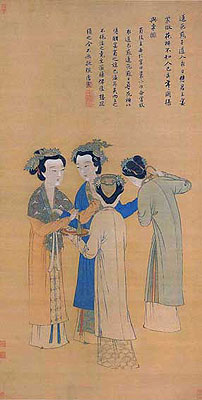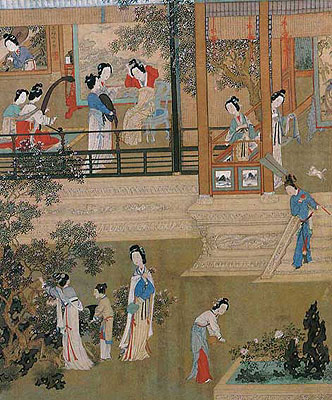
During the Ming Dynasty (1368-1644),Suzhoubecame a gathering place for Chinese intellectuals, including many well-known painters. According to historical records, some 150 painters, about one-fifth of all the Ming Dynasty painters, were inSuzhou, and they formed an influential school of painting. HistoricallySuzhouwas also known as Wumen, and this painting school was named theWumenPaintingSchool. Shen Zhou was its most influential painter; other famous members were Wen Zhengming, Tang Yin and Chou Ying.

Shen Zhou (1427-1509) and Wen Zhengming (1470-1559) were major representatives of theWumenSchool. Shen was also good at flower and bird painting; these works form a transition to free-sketch flower and bird painting. Shen drew upon the inheritance from the painting traditions of the Song and Yuan Dynasties and formed his own fresh and elegant painting style. Wen Zhengming was a student of Shen Zhou, so he obtained a solid grounding in painting and mastered good brushstroke techniques. He led a comfortable life as a scholar-official, and as a result he failed to develop a wide perspective in his creative work. His works can be divided into two types -- bold black ink landscape paintings and refined and elegant green landscape paintings in a meticulous style, such asInnumerableMountainsand Valleys. Tang Yin (1470-1523), alias Tang Bohu, was a student of Shen Zhou. He was accomplished in poetry, prose and calligraphy, and excelled especially in painting. Tang Yin had an unrestrained personality, experienced many hardships in life and was poor and frustrated in his later years. He died in his fifties. Tang followed the Southern Song Dynasty painting style but was not fettered by old conventions. He was good at landscape, flower and bird and figure paintings in both free sketches and fine brushwork. His paintings on folklore themes reveal the rich flavor of life, and his brushstrokes are fluid, vigorous and elegant. He inherited old traditions but created his own style.

At the same period of theWumenSchool, there was another influential school -- theYuantiSchool(palace painting). The palace paintings of Lin Liang and Lv Ji combined the two styles of both the free sketching and the ink painting. During the reigns of Emperors Longqing, Wanli and Chongzhen of the Ming Dynasty (1567-1644), theWumenSchoolflourished. Though the subjects ofWumenSchoolpaintings were limited due to the painters' narrow life circles, and some of their works were repetitive in content, these painters inherited traditional Chinese painting skills to give vivid presentation of the figures they depicted. They were all men of considerable culture and had their respective aesthetic pursuits. Their brushstroke techniques and creative painting methods had a tremendous impact on painters of later times.










